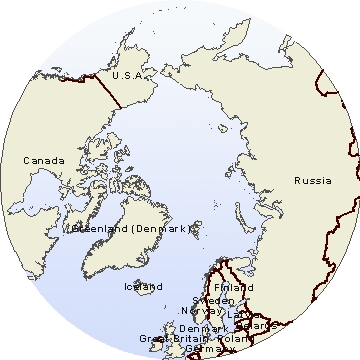|
Did Iceland's volcanic eruption really cause Alaska's year of two winters? Or could it be mere coincidence that 1783 marks the year both of Gordon Jacoby's unique tree ring and Iceland's Laki eruption?
At Reading University, in England, Eleanor Highwood is seeking the answer using a climate model run on a super computer. The simulation attempts to replicate the effect of the Laki eruption on the global climate of the entire northern hemisphere.
We certainly were prompted to look at Alaska as a particular focus of the study because of Jacoby's theory concerning the cold temperatures leading to problems with the Inuit population.


Click on map to go to the United Nations Environment Program site to zoom in to this map
In her research on Laki, Highwood calculated temperatures throughout the northern hemisphere with and without the eruption.
[W]e do see quite a lot of temperature changes in the northern hemisphere. In particular throughout the whole of June of 1783 to February 1784 we see very cold temperatures - a difference of about two degrees Celsius - over much of Northeastern Canada. In Europe it's less definitive. In some months we get a slight warming, and in some months we get a slight cooling. […and] briefly we have looked at Alaska.
We have the whole temperature changes in the whole Northern hemisphere. It doesn't look like there is a major cold spot in Alaska due to Laki in our simulation.
Highwood's computer model shows some evidence of cooling in Alaska after Laki, but not the frigid summer Gordon Jacoby has found. There could be a number of reasons why, Highwood says.
Either we don't have the circulation in the right place, or we don't have enough aerosols being blown into the right place. […A]lternatively there are always problems interpreting tree-ring data. The other problem is that Laki wasn't the only thing affecting climate in 1783. There may have been cold temperatures in Alaska due to reasons that have nothing to do with the Laki eruption. For instance, there was an eruption of a Japanese volcano, Asama, which may have produced extra aerosols and you can imagine that would have been blown quite quickly to the western coast of the United States.
Improvements to the model could help Highwood sort out which explanation is correct. She says her research is still preliminary. The key to understanding Laki's effect on Alaska is most likely the circulation of wind. Gordon Jacoby says the wind can create some regions of intense cold, and leave others alone.
This cooling effect isn't uniform. It just causes outbreaks of colder than usual air from the polar regions. …you get local areas where you have more outbreaks of cold polar air. Conversely you have some areas that get a little bit warmer as a result of this disturbance.
This kind of research - plugging in numbers - digging through oral history archives, and boring into trees is the nitty gritty detail work of studying how earth's climate works. Highwood contends that scientists trying to fathom the human impact on climate need to understand natural forces first, including volcanoes.
Volcanoes are an important part of the natural climate system, and we need to know how the natural process - like volcanoes and changes in the sun - affect the climate system before we can tell if mankind has had any influence on the climate whatsoever. So if we're looking at global warming effects in our climate models, we need to include the effects of volcanoes as well. …if our work shows that those cold temperatures were due to this [Laki] eruption - that's a significant advance. …it does show that volcanoes, not as explosive as those that are normally studied, can have a significant effect on climate and Jacoby's theory is an important way of validating our model results.
Though their techniques are completely different, scientists like dendrochronologist Gordon Jacoby, volcanologist Thor Thardorson and climate modeler Eleanor Highwood are all striving to understand, and perhaps forecast, the weather. It might seem surprising that the traditions of Alaska's Kauwerak Eskimoes and the scientific investigations of these researchers intersect. But if there is one thing climate researchers are learning it is that earth is one system of cause and effect where a disruption in one place can have far flung repercussions. Benjamin Franklin may have been the first scientist to notice this fact when he postulated that a volcanic eruption, by blocking the sun's rays, caused cool weather thousands of miles away. The year was 1783. The volcano was Iceland's Laki outburst.
|




















































